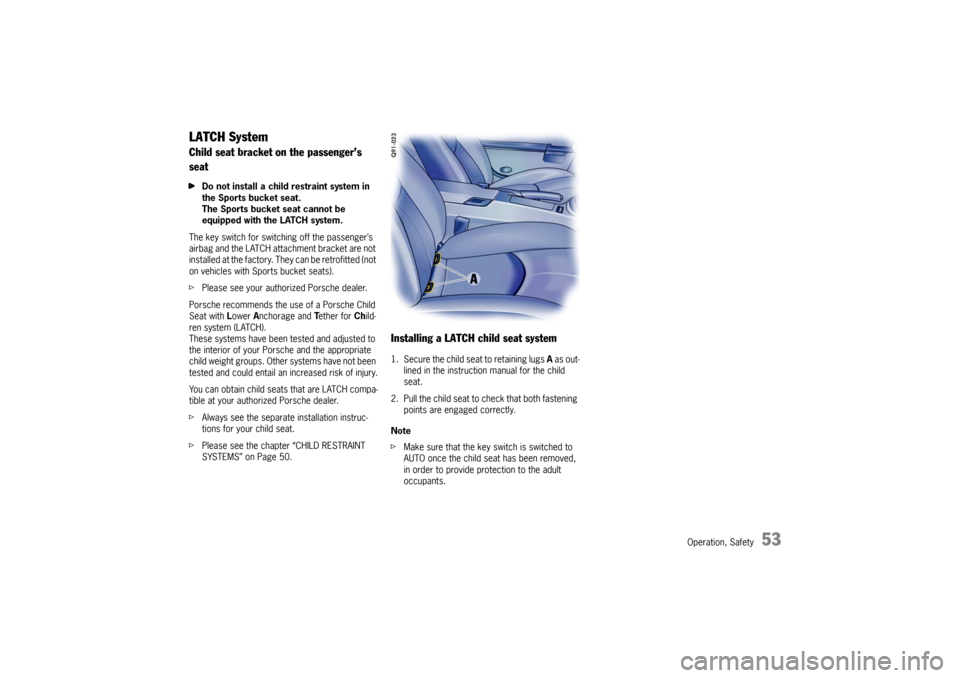2009 PORSCHE CAYMAN weight
[x] Cancel search: weightPage 55 of 284

Operation, Safety
53
LATCH SystemChild seat bracket on the passenger’s
seatfDo not install a child restraint system in
the Sports bucket seat.
The Sports bucket seat cannot be
equipped with the LATCH system.
The key switch for switching off the passenger’s
airbag and the LATCH attachment bracket are not
installed at the factory. They can be retrofitted (not
on vehicles with Sports bucket seats).
f Please see your authorized Porsche dealer.
Porsche recommends the use of a Porsche Child
Seat with Lower A nchorage and Tether for Ch ild-
ren system (LATCH).
These systems have been tested and adjusted to
the interior of your Porsche and the appropriate
child weight groups. Other systems have not been
tested and could entail an increased risk of injury.
You can obtain child seats that are LATCH compa-
tible at your authorized Porsche dealer.
f Always see the separate installation instruc-
tions for your child seat.
f Please see the chapter “CHILD RESTRAINT
SYSTEMS” on Page 50.
Installing a LATCH child seat system1. Secure the child seat to retaining lugs A as out-
lined in the instruction manual for the child
seat.
2. Pull the child seat to check that both fastening points are engaged correctly.
Note
f Make sure that the key switch is switched to
AUTO once the child seat has been removed,
in order to provide protection to the adult
occupants.
Page 107 of 284

Operation, Safety
105
Roof Transport SystemfPlease follow the separate instructions for fit-
ting the Roof Transport System.
f Only use Roof Transport Systems from the
Porsche Tequipment product range or Roof
Transport Systems which have been tested
and approved for your car by Porsche. Fitting
normal commercially available luggage racks
is not possible.
The Porsche Roof Transport System allows you
to carry various sports and hobby equipment.
Your Porsche partner will be pleased to tell you
about the various different uses of the Roof Trans-
port System.
Caution!
f Risk of damage to the paint on the rear lid.
Only open the rear lid if this cannot touch the
load.
f Completely remove the Roof Transport System
b e f o re u s i n g a n a u t o m a t i c c a r w a s h - r i s k o f d a -
mage to the vehicle!
f Do not exceed the maximum permitted pay-
load of 132 lbs. (60 kg), the maximum permit-
ted gross weight and the maximum permitted
axle loads.
f Please see the chapter “WEIGHTS” on
Page 272. f
Distribute load evenly, storing heavy items as
low as possible. Items of luggage must not
project beyond the side of the load area.
f Fix and secure every item to the basic carrier
with a rope or lashing strap (do not use elastic
rubber tensioners).
f Before every trip, and at regular intervals
during long trips, check that Roof Transport
System and load are secu re. Re-tighten if ne-
cessary and secure additionally by locking.
f When the Roof Transport System is loaded, the
maximum speed depends on the nature, size
and weight of the load being carried. But never
drive faster than 90 mph (140 km/h).
f With the basic carrier fitted and no load, do not
exceed a maximum speed of 110 mph
(180 km/h).
f Driving, braking and steering behavior change
due to the higher center of gravity and the gre-
ater wind-resistant area. You should adapt your
driving style appropriately.
f Since fuel consumption and noise are incre-
ased with the Roof Transport System fitted, it
should not remain on the vehicle if not in use.
Page 172 of 284

170
Warnings
PSM onPorsche Stability Management has been
switched on.
PSM failure Have the fault remedied at an authorized
Porsche dealer.
PSM
initialisation Please observe the chapter “PUTTING VEHICLE
INTO OPERATION“.
PASM Normal/Sport Indicator for selected PASM mode
PASM failure Have the fault remedied at an authorized
Porsche dealer.
PASM indicator faulty Have the fault remedied at an authorized
Porsche dealer.
Sport mode failure Have the fault remedied at an authorized
Porsche dealer.
Airbag system fault Airbag is faulty.
Have the fault remedied at an authorized
Porsche dealer.
Check passenger’s seat setting Weight sensing is impaired on the front passenger's seat (Advanced Airbag).
Correct the seating position, set the backrest
upright, do not support weight on the armrests,
or lift on the handles.
Failure spoiler control Driving stability is impaired.
Adjust your driving style. Reduce speed.
Have the fault remedied at an authorized
Porsche dealer.
Display of
selector lever posi-
tion flashes Selector lever is not engaged Porsche Doppelkupplung:
Selector lever can be between two positions.
Engage the selector lever correctly.
Instrument
panel On-board
computerText display on on-board
computer Meaning/measure
Page 196 of 284

194
Maintenance, Car Care
Fuel Economy Fuel economy will vary depending on where,
when and how you drive, optional equipment
installed, and the general condition of your
car.
A car tuned to specifications and correctly
maintained, will help you to achieve optimal
fuel economy.
fHave your vehicle tuned to specifications.
Air cleaner should be dirt free to allow proper
engine “breathing”.
Battery should be fully charged.
Wheels should be properly aligned.
Tires should be inflated at correct pressure.
f Always monitor your fuel consumption.
f Drive smoothly, avoid abrupt changes in speed
as much as possible.
f Avoid jack rabbit starts and sudden stops.
f Do not drive longer than necessary in the lower
gears. Shifting into a higher gear early without
lugging the engine will help save fuel.
f Prolonged “warm up” idling wastes gas. Start
the vehicle just before you are ready to drive.
Accelerate slowly and smoothly.
f Switch off the engine if stationary for longer
periods. f
Any additional weight carried in the vehicle re-
duces fuel economy. Always keep cargo to a
minimum and remove all unnecessary items.
f Organize your trips to take in several errands
in one trip.
f All electrical accessories contribute to in-
creased fuel consumption.
f Only switch on the air conditioning when neces-
sary.
f Do not drive with the Ro of Transport System
mounted unless you need it.
The EPA estimated mpg. is to be used for
comparison purposes, actual mileage may
be different from the estimated mpg.,
depending on your driving speed, weather
conditions and trip length. Your actual
highway mileage will probably be less than
the estimated mpg.
f Please observe all local and national speed
limits.
Operating your Porsche in other
Countries Government regulations in the United States and
Canada require that automobiles meet specific
emission regulations and safety standards. There-
fore, cars built for the U.S. and Canada differ from
vehicles sold in other countries.
If you plan to take your Porsche outside the conti-
nental limits of the United States or Canada, there
is the possibility that
– unleaded fuel may not be available;
– unleaded fuel may have a considerably lower
octane rating. Excessive engine knock and se-
rious damage to both engine and catalytic con-
verters could result;
– service ma y be inadequa te due to lack of prop- er service facilities, tools or diagnostic equip-
ment;
– replacement parts may not be available or very difficult to get.
Porsche cannot be responsible for the
mechanical damage that could result
because of inadequate fuel, service or parts
availability.
If you purchased your Porsche abroad and want to
bring it back home, be sure to find out about ship-
ping and forwarding requirements, as well as cur-
rent import and customs regulations.
Page 218 of 284

216
Practical Tips, Emergency Service
B Vehicle load limit
Is the maximum total weight limit specified of
the load (passengers and cargo) for the vehi-
cle. This is the maximum weight of passengers
and cargo that can be loaded into the vehicle.
Please see the chapter “LOADING INFORMA-
TION” on Page 224.
C Tire size for the front axle Check with your authorized Porsche dealer
about the current release status.
D Recommended tire pre ssure for the front axle
These values are for cold tires (68 °F/20 °C).
E Tire size for the rear axle Check with your authorized Porsche dealer
about the current release status.
F Recommended tire pressure for the rear axle. These values are for cold tires (68 °F/20 °C).
G In vehicles with collapsible spare wheel: Size and tire pressure of the spare wheel.
Tire traction
Warning!
When driving on wet or slushy roads, a
wedge of water may build up between the
tires and the road. This phenomenon is
known as “hydroplane” and may cause par-
tial or complete loss of traction, vehicle
control or stopping ability.
f Reduce speed on wet surface to prevent this. Tire life Tire life depends on vari ous factors, i. e., road
surfaces, traffic and wea ther conditions, driving
habits, type of tires and tire care.
f Inspect your tires for wear and damage before
driving off. If you notice uneven or substantial
wear, wheels might need alignment or tires
should be balanced or replaced.
Tire wear The original equipment tires on your Porsche have
built-in tire wear indicato rs. They are molded into
the bottom of the tread grooves and will appear as
approximately 1/2 in. (12 mm) bands when the
tire tread depth is down to 1/16 of an in.
(1.6 mm).
When the indicators appear in two or more adja-
cent grooves, it is time to replace the tires. We
recommend, however, that you do not let the tires
wear down to this extent.
Worn tires cannot grip the road surface properly
and are even less effective on wet roads.
Snow tires lose their traction capability when their
tread depth falls below 5/32 in. (4 mm).
In the United States, state laws may govern the
minimum tread depth permissible. Follow all such
laws.
Page 221 of 284

Practical Tips, Emergency Service
219
Parking at the curb
Warning!
Hard impacts against curbs (or traffic
islands) are dangerous and may cause hid-
den tire damage which is not noticeable until
later. Such damage can result in accidents at
high speeds causing serious personal injury
or death.
Depending on the force of impact, the edge
of the rim can also be damaged.
f If you are in doubt, have the wheel checked by
an expert, particularly if you suspect damage
on the inside.
f If you must drive over a curb or other obstacle,
drive slowly and at an obtuse angle. Exercise care when parking along curbs.
Wheel alignment, wheel balancing As a precaution, have wheels with summer tires
balanced in the spring, and those with mud and
snow tires before winter.
Unbalanced wheels may affect car handling and
tire life.
Only the specified weight s may be used for wheel
balancing.
Self-adhesive weights must not come into contact
with cleaning agents, since they could drop off.
Uneven tread wear indicates wheel imbalance. In
this event, the vehicle should be checked at an au-
thorized Porsche dealer.
Warning!
If, during a trip, uneven running or vibrations
occur that could be caused by damage to
tires or the car, the speed must be reduced
immediately, but without braking sharply.
If you continue your trip without having the
cause of the fault reme died, you might lose
control of your vehicle which could cause se-
rious personal injury or death.
f Stop the vehicle and check the tires.
f If no cause for the fault can be found, drive
carefully to the nearest authorized Porsche dealer.
Wheels with Tire Pressure Monitoring
(TPM) sensorsBefore changing wheels, make sure that the
wheels are compatible with your vehicle's TPM.
f Check this with your authorized Porsche
dealer.Removing and storing tires fAfter changing, adjust tire pressure and torque
wheel bolts diagonally to 94 ftlb (130 Nm).
Tires must always remain on the same side of
the vehicle.
When wheels are removed, the direction of
rotation and position of each wheel should be
marked.
Example
FR (front right), FL, RR and RL.
Wheels must always be fitted in accordance with
their marking.
The perception that tire durability and perform-
ance are immune to the effects of storage and
age is unfounded.
Chemical additives, whic h make the rubber elas-
tic, lose their effectivene ss in the course of time
and the rubber becomes brittle and cracks.
Therefore, the tires should be inspected from
time to time.
Page 226 of 284

224
Practical Tips, Emergency Service
Loading InformationDefinitionsThe Curb weight - actual weight of your vehicle -
vehicle weight including standard and optional
equipment, fluids and emergency tools. This
weight does not include passengers and cargo.
The Gross Vehicle Weight is sum of the curb
weight and the weight of passengers and cargo
combined.
The Gross Vehicle Weight Rating is the maxi-
mum total weight of vehicl e, passengers, luggage
and optional equipment.
The Gross Axle Weight Rating is the maximum
load limit for the front or the rear axle. This infor-
mation is located on the safety compliance sticker
located in the driver’s side door jamb.
For determining the compat ibility of the tire and
vehicle load capabilities:
f Please see the chapter “TECHNICAL DATA” on
Page 266.
The load capacity coeffici ent (e.g. “100”) is a min-
imum requirement. The Gross Combined Weight Rating is the
maximum total weight rating of vehicle, passen-
gers and cargo.
The Vehicle Capacity Weight
- Load Limit - is
the maximum total weight limit specified of the
load (passengers and cargo) for the vehicle. This
is the maximum weight of passengers and cargo
that can be loaded into the vehicle. This informa-
tion can be found on the tire pressure plate.
The maximum loaded vehicle weight is the
sum of curb weight, accessory weight, vehicle ca-
pacity weight and production options weight.
The load rating is the maximum load that a tire
is rated to carry for a given inflation pressure.
The maximum load rating is the load rating for
a tire at the maximum permissble inflation pres-
sure.
The cargo capacity is the permissible weight of
cargo, the substracted weight of passengers from
the load limit.
f Never exceed the permissible limits.
Danger!
Risk of loss of control, damage to the vehicle
and serious personal injury or death.
f Never exceed the specified axle loads.
Overloading can shorten the service life of the
tires and car, as well as lead to dangerous
vehicle reactions and long braking distances.
Damage due to overloading is not covered by the vehicle warranty.
Page 227 of 284

Practical Tips, Emergency Service
225
Example for determining the combined weight of
occupants and cargoVehicle Load CapacityfThe combined weight of occupants and cargo
should never exceed the weight shown on the
tire plate in the vehicle.
Please see the chapter “TIRE PRESSURE PLA-
TE” on Page 265.
f Never exceed the number of passengers
shown on the tire pressure plate in the vehicle. Determining the combined weight of
occupants and cargo:
f
Add the weight of all occupants and then add
the total luggage weight ( figure).
Steps for determining correct load limit
1. Locate the statement "The combined weight of occupants and cargo should never exceed XXX
pounds" on your vehicle’s placard (depending
on the date of manufacture).
2. Determine the combined weight of the driver and passengers that will be riding in your vehi-
cle. 3. Subtract the combined weight of the driver and
passengers from XXX kilograms or XXX
pounds.
4. The resulting figure equals the available amount of cargo and luggage load capacity.
For example, if the ”XXX“ amount equals
400 lbs. and there will be two - 150 lb passen-
gers in your vehicle, the amount of available
cargo and luggage load capacity is 100 lbs.
(400 - 300 (2 x 150) = 100 lbs.).
5. Determine the combined weight of luggage and cargo being loaded on the vehicle. That
weight may not safely ex ceed the available car-
go and luggage load capacity calculated in
Step 4.